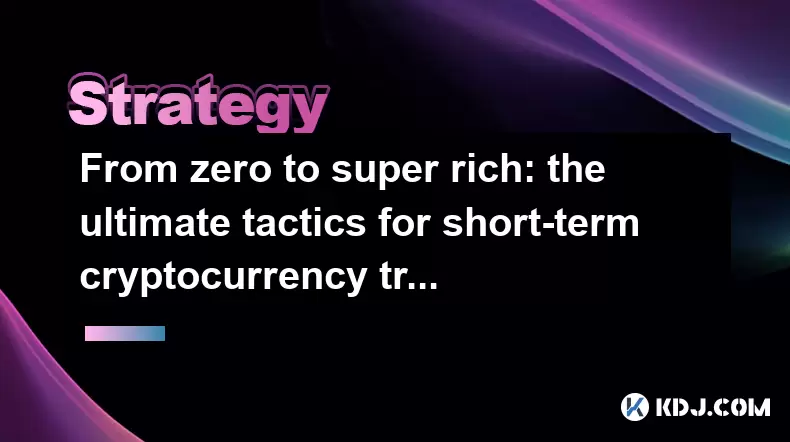-
 bitcoin
bitcoin $122659.385674 USD
0.52% -
 ethereum
ethereum $4484.113342 USD
-0.09% -
 bnb
bnb $1304.229256 USD
-0.85% -
 tether
tether $1.000204 USD
-0.03% -
 xrp
xrp $2.860636 USD
-0.51% -
 solana
solana $227.288799 USD
2.36% -
 usd-coin
usd-coin $0.999805 USD
0.01% -
 dogecoin
dogecoin $0.252837 USD
1.18% -
 tron
tron $0.341149 USD
1.12% -
 cardano
cardano $0.830507 USD
0.33% -
 hyperliquid
hyperliquid $45.792319 USD
0.04% -
 chainlink
chainlink $22.422164 USD
1.55% -
 ethena-usde
ethena-usde $1.000283 USD
0.01% -
 sui
sui $3.511389 USD
0.83% -
 stellar
stellar $0.385276 USD
-0.44%
From zero to super rich: the ultimate tactics for short-term cryptocurrency trading
Short-term crypto trading can lead to wealth with the right tactics; this article provides strategies for beginners and experts to maximize profits and minimize risks.
May 31, 2025 at 02:01 pm

From zero to super rich: the ultimate tactics for short-term cryptocurrency trading
Short-term cryptocurrency trading can be an exhilarating journey from zero to super rich, but it requires a strategic approach and a deep understanding of the market. The tactics outlined in this article will equip you with the knowledge and skills needed to navigate the volatile world of cryptocurrency trading effectively. Whether you are a beginner or an experienced trader, these strategies can help you maximize your profits and minimize your risks in the short term.
Understanding the Basics of Short-Term Trading
Before diving into the tactics, it's crucial to understand what short-term trading entails. Short-term trading, often referred to as day trading, involves buying and selling cryptocurrencies within a short period, typically within a day or a few days. The primary goal is to capitalize on small price movements and generate quick profits. This type of trading requires constant monitoring of the market and a keen eye for trends and patterns.
To succeed in short-term trading, you need to be well-versed in technical analysis, which involves studying charts and using indicators to predict future price movements. Tools like moving averages, Relative Strength Index (RSI), and Bollinger Bands can help you identify potential entry and exit points. Additionally, staying updated with the latest news and developments in the crypto space is essential, as they can significantly impact market sentiment and prices.
Choosing the Right Cryptocurrency for Short-Term Trading
Not all cryptocurrencies are suitable for short-term trading. When selecting a cryptocurrency, consider factors such as liquidity, volatility, and trading volume. High liquidity ensures that you can easily enter and exit trades without significantly affecting the price. Volatility, while risky, can also offer substantial profit opportunities. A cryptocurrency with high trading volume indicates active market participation, which is crucial for short-term trading.
Some popular cryptocurrencies for short-term trading include Bitcoin (BTC), Ethereum (ETH), and Litecoin (LTC). These assets are known for their liquidity and volatility, making them ideal for short-term traders. However, it's also worth exploring lesser-known altcoins, as they can sometimes offer higher returns due to their smaller market caps and higher volatility.
Developing a Robust Trading Strategy
A well-defined trading strategy is the backbone of successful short-term trading. Your strategy should include clear entry and exit rules, risk management techniques, and a plan for handling different market scenarios. Here are some key elements to consider when developing your trading strategy:
- Entry and Exit Points: Determine the specific conditions under which you will enter and exit a trade. This could be based on technical indicators, price levels, or market news.
- Risk Management: Set stop-loss orders to limit potential losses. Decide on the percentage of your portfolio you are willing to risk on each trade.
- Position Sizing: Calculate the size of your positions based on your risk tolerance and account size. Avoid over-leveraging, as it can lead to significant losses.
- Trading Journal: Keep a detailed journal of your trades, including the rationale behind each decision, the outcome, and lessons learned. This will help you refine your strategy over time.
Leveraging Technical Analysis for Short-Term Gains
Technical analysis is a critical tool for short-term traders. By analyzing historical price data and market trends, you can make informed decisions about when to buy and sell. Here are some technical indicators and patterns that can be particularly useful for short-term trading:
- Moving Averages: Use simple moving averages (SMA) and exponential moving averages (EMA) to identify trends and potential reversal points. For example, a crossover of a short-term moving average above a long-term moving average may signal a buying opportunity.
- Relative Strength Index (RSI): The RSI helps you gauge the momentum of a cryptocurrency. An RSI reading above 70 indicates overbought conditions, while a reading below 30 suggests oversold conditions.
- Candlestick Patterns: Familiarize yourself with common candlestick patterns such as doji, hammer, and engulfing patterns. These can provide insights into potential trend reversals.
- Bollinger Bands: Bollinger Bands can help you identify periods of high and low volatility. When the price touches the upper band, it may be overbought, and when it touches the lower band, it may be oversold.
Utilizing Trading Bots and Algorithms
In the fast-paced world of short-term trading, trading bots and algorithms can give you a competitive edge. These automated tools can execute trades based on predefined criteria, allowing you to take advantage of market opportunities 24/7. Here's how you can leverage trading bots for short-term trading:
- Choose the Right Bot: Select a trading bot that aligns with your trading strategy and goals. Popular options include 3Commas, Cryptohopper, and HaasOnline.
- Set Up Your Bot: Configure your bot with your trading parameters, such as entry and exit rules, risk management settings, and the cryptocurrencies you want to trade.
- Backtest Your Strategy: Before going live, backtest your bot's strategy using historical data to ensure its effectiveness. Adjust the parameters as needed to optimize performance.
- Monitor and Adjust: Even with automated trading, it's essential to monitor your bot's performance and make adjustments based on market conditions and your trading results.
Managing Emotions and Psychology
Short-term trading can be emotionally challenging, as it involves quick decision-making and dealing with significant price fluctuations. Managing your emotions and maintaining a disciplined approach are crucial for long-term success. Here are some tips to help you stay on track:
- Stick to Your Plan: Follow your trading strategy religiously and avoid making impulsive decisions based on emotions.
- Accept Losses: Understand that losses are a part of trading. Instead of dwelling on them, focus on learning from your mistakes and improving your strategy.
- Take Breaks: Trading can be mentally exhausting. Take regular breaks to recharge and maintain a clear mind.
- Stay Positive: Maintain a positive mindset and believe in your ability to succeed. Surround yourself with supportive communities and resources.
Frequently Asked Questions
Q: How much capital do I need to start short-term cryptocurrency trading?A: The amount of capital required to start short-term trading can vary based on your risk tolerance and trading strategy. However, a common recommendation is to start with at least $1,000 to $5,000. This allows you to diversify your trades and manage risk effectively. Remember, never invest more than you can afford to lose.
Q: Can short-term trading be profitable for beginners?A: Yes, short-term trading can be profitable for beginners, but it comes with a steep learning curve. It's essential to educate yourself thoroughly, start with small trades, and gradually increase your exposure as you gain experience. Utilizing demo accounts and paper trading can help you practice without risking real money.
Q: What are the tax implications of short-term cryptocurrency trading?A: Short-term trading gains are typically taxed as ordinary income in many jurisdictions. It's important to keep detailed records of your trades, including dates, amounts, and profits or losses, to accurately report your income for tax purposes. Consult with a tax professional to understand the specific tax laws and regulations in your area.
Q: How can I protect myself from scams and fraudulent schemes in short-term trading?A: To protect yourself from scams, always use reputable exchanges and trading platforms, enable two-factor authentication (2FA) on your accounts, and be cautious of unsolicited offers or promises of high returns. Research thoroughly before investing in any new cryptocurrency or trading service, and never share your private keys or personal information with anyone.
Disclaimer:info@kdj.com
The information provided is not trading advice. kdj.com does not assume any responsibility for any investments made based on the information provided in this article. Cryptocurrencies are highly volatile and it is highly recommended that you invest with caution after thorough research!
If you believe that the content used on this website infringes your copyright, please contact us immediately (info@kdj.com) and we will delete it promptly.
- CEA Industries & Jon Najarian: Bridging Traditional Finance with BNB
- 2025-10-09 21:05:16
- Binance Alpha's AB Token Crash: A Cautionary Tale in Cryptocurrency
- 2025-10-09 20:45:17
- Crypto Investors Embrace Stock-Picking: Bitwise CEO's Insight
- 2025-10-09 21:05:16
- Coinbase, Cruise, and Crypto Compliance: Navigating the Waters of Digital Finance
- 2025-10-09 21:10:12
- Crypto ETFs, Altcoins, and Wall Street: Navigating the New Frontier
- 2025-10-09 20:45:17
- Bitcoin's Decade of Dominance: A Super Reason to Hold for the Next 10 Years?
- 2025-10-09 20:25:15
Related knowledge

Practical parameter settings for a Bitcoin multi-timeframe moving average system
Sep 18,2025 at 10:54pm
Optimizing Timeframe Combinations for Bitcoin Trading1. Selecting appropriate timeframes is crucial when building a multi-timeframe moving average sys...

How can I filter out false breakouts in Dogecoin high-frequency trading?
Sep 22,2025 at 01:00am
Understanding False Breakouts in Dogecoin Trading1. A false breakout occurs when Dogecoin's price appears to move beyond a defined support or resistan...

Techniques for identifying tops and bottoms in the Bitcoin on-chain NVT model
Sep 20,2025 at 07:54pm
Understanding the NVT Model in Bitcoin Analysis1. The Network Value to Transactions (NVT) ratio is often described as the 'P/E ratio' of the cryptocur...

What does the surge in open interest in Bitcoincoin futures mean?
Sep 20,2025 at 11:18pm
Understanding the Surge in Dogecoin Futures Open Interest1. A surge in open interest within Dogecoin futures indicates a growing number of active cont...

How can I use the Ethereum USDT premium to gauge market sentiment?
Sep 18,2025 at 11:55pm
Understanding the Ethereum USDT Premium1. The Ethereum USDT premium refers to the price difference between USDT (Tether) traded on Ethereum-based plat...

What should I do if Ethereum staking yields decline?
Sep 20,2025 at 06:18am
Understanding the Causes Behind Declining Ethereum Staking Yields1. The Ethereum network transitioned to a proof-of-stake consensus mechanism with the...

Practical parameter settings for a Bitcoin multi-timeframe moving average system
Sep 18,2025 at 10:54pm
Optimizing Timeframe Combinations for Bitcoin Trading1. Selecting appropriate timeframes is crucial when building a multi-timeframe moving average sys...

How can I filter out false breakouts in Dogecoin high-frequency trading?
Sep 22,2025 at 01:00am
Understanding False Breakouts in Dogecoin Trading1. A false breakout occurs when Dogecoin's price appears to move beyond a defined support or resistan...

Techniques for identifying tops and bottoms in the Bitcoin on-chain NVT model
Sep 20,2025 at 07:54pm
Understanding the NVT Model in Bitcoin Analysis1. The Network Value to Transactions (NVT) ratio is often described as the 'P/E ratio' of the cryptocur...

What does the surge in open interest in Bitcoincoin futures mean?
Sep 20,2025 at 11:18pm
Understanding the Surge in Dogecoin Futures Open Interest1. A surge in open interest within Dogecoin futures indicates a growing number of active cont...

How can I use the Ethereum USDT premium to gauge market sentiment?
Sep 18,2025 at 11:55pm
Understanding the Ethereum USDT Premium1. The Ethereum USDT premium refers to the price difference between USDT (Tether) traded on Ethereum-based plat...

What should I do if Ethereum staking yields decline?
Sep 20,2025 at 06:18am
Understanding the Causes Behind Declining Ethereum Staking Yields1. The Ethereum network transitioned to a proof-of-stake consensus mechanism with the...
See all articles


























![🚨IS VECHAIN (VET) A DEAD COIN ?? PRICE ANALYSIS [GET READY NOW] 🚨IS VECHAIN (VET) A DEAD COIN ?? PRICE ANALYSIS [GET READY NOW]](/uploads/2025/10/09/cryptocurrencies-news/videos/vechain-vet-dead-coin-price-analysis-ready/68e7b200b067b_image_500_375.webp)















































